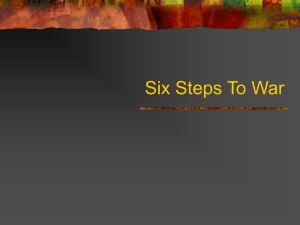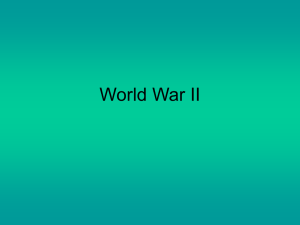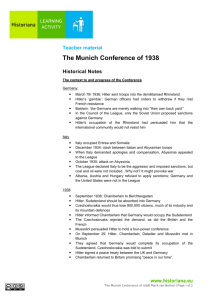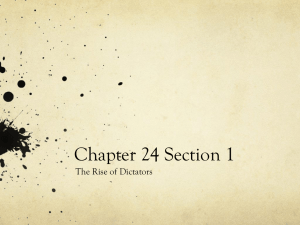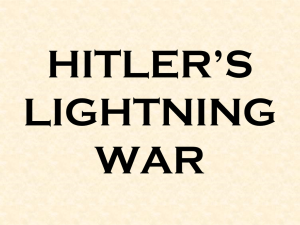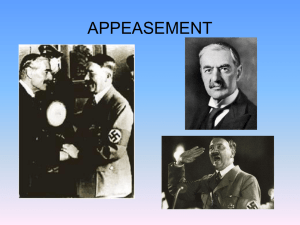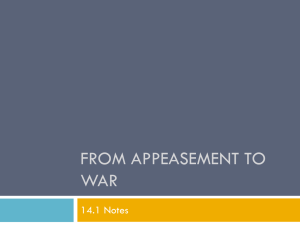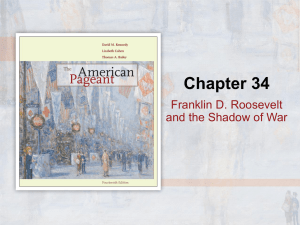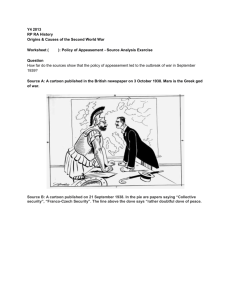Breakdown of Cooperation
advertisement
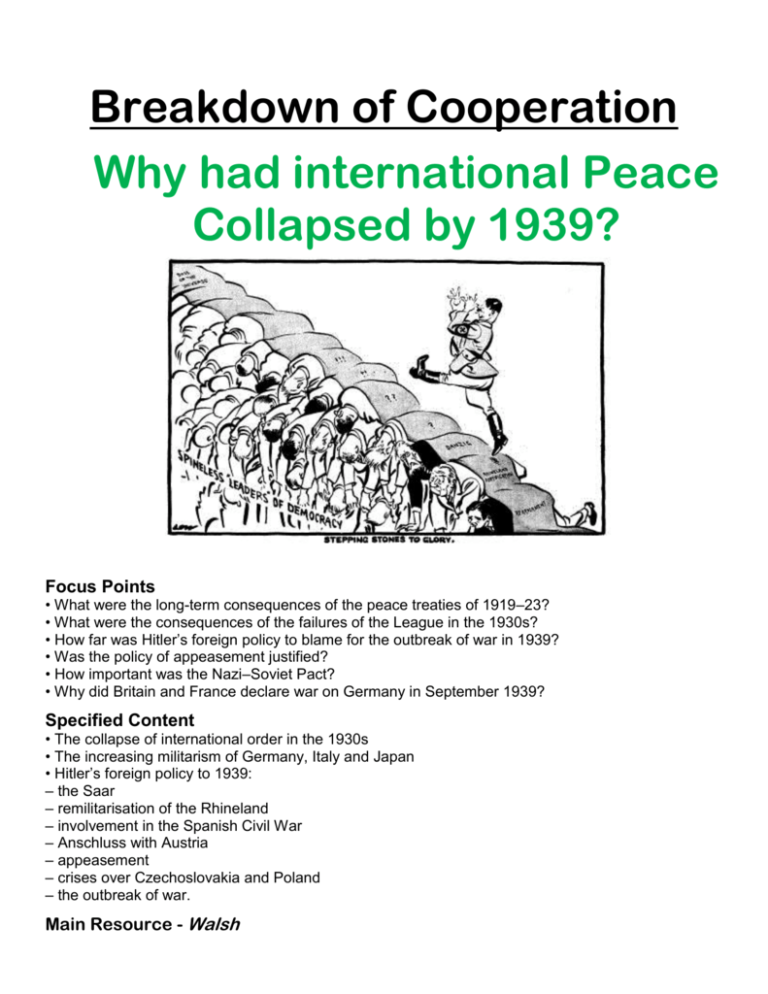
Breakdown of Cooperation Why had international Peace Collapsed by 1939? Focus Points • What were the long-term consequences of the peace treaties of 1919–23? • What were the consequences of the failures of the League in the 1930s? • How far was Hitler’s foreign policy to blame for the outbreak of war in 1939? • Was the policy of appeasement justified? • How important was the Nazi–Soviet Pact? • Why did Britain and France declare war on Germany in September 1939? Specified Content • The collapse of international order in the 1930s • The increasing militarism of Germany, Italy and Japan • Hitler’s foreign policy to 1939: – the Saar – remilitarisation of the Rhineland – involvement in the Spanish Civil War – Anschluss with Austria – appeasement – crises over Czechoslovakia and Poland – the outbreak of war. Main Resource - Walsh A Basic Pattern for ALL Source Questions……. CONTENT – State the Obvious. The source tells me/shows……. This may mean that………….. A cartoon about the peace negotiations published in a British newspaper in 1919 ORIGIN – State what’s going on immediately around the source? What’s its provenance? Who published it? When? Why? PURPOSE – State what’s going on in History around the time the source was written/drawn. Can context help you explain the author’s/artist’s purpose? Remember C.O.P. Content, Origin, Purpose. CARTOON SOURCE QUESTIONS Examine the example below then try writing answers for the questions that follow CONTENT (so ‘in the source I see…… this may mean…… x3) In the source I se… This may mean… In the source I see… This may mean… In the source I see… This may imply… ORIGIN (talk about the time and author – could they be bias?) TIME – This cartoon was published around the time of ….. AUTHOR – The author is unknown I’m therefore not aware if they are likely to have held a particular perspective or not. (most cartoons on your test-paper will have the country of origin printed below them) PURPOSE (talk about the context, what’s going on at that time and say what you think the main purpose of the source is) The purpose of the cartoon is ….. Question – What is the message of this source? Question – What is the message of this source? Question – What is the message of this source? , What, no chair for me? (Britain, 30th September, 1938) Question – What is the message of this source? CCCP is the anachronism for the Russian for USSR Soviet view of the Munich Agreement, 1938 The two policemen directing Hitler are Daladier (the French Premier) and Chamberlain (the British prime Minister). Question – What is the message of this source? Question – What is the message of this source? A Practise Paper 2 Source A Spineless Leaders of Democracy Source B Appeasement The victors of the First World War took no actions to prevent Germany becoming strong again. Partly this was due to their reaction against the slaughter of 1914-18. Another war, they reasoned, would be even more destructive than the first, and therefore had at all costs to be avoided. Also, they believed that Hitler had just grievances, which ought to be removed. By the 1930s it was widely thought that the First World War had not been caused by German aggression: therefore Versailles had been built on false premises and ought to be revised. Why should Germans be forced to limit the size of their army? Why should they not have troops on their own territory, including the Rhineland? Why shouldn’t all Germans be united in a single state, if that was what they wanted? On the other hand, the British and French governments, while hoping that Hitler would soon cease to make demands, did prepare for the worst by rearming in case they had to fight. Article from History Today magazine Source C 1919 the Treaty of Versailles 1924 the Dawes Plan, scaling down reparations 1925 the Locarno Treaty; publication of Mein Kampf 1926 Germany enters the League of Nations 1929 the Young Plan; death of Stresemann; Wall Street crash 1930 Allied troops leave the Rhineland 5 years ahead of schedule 1931 Japan invades Manchuria 1933 Hitler comes to power; Germany leaves League of Nations 1934 Hitler introduces conscription 1935 Mussolini invades Abyssinia 1936 (March) remilitarisation of the Rhineland; (November) Anti-Comintern pact 1938 (March) Anschluss between Germany and Austria; (September) Munich conference, ceding Sudetenland to Germany 1939 (March) Hitler invades rump of Czechoslovakia; (May) Pact of Steel between Hitler and Mussolini; (23 August) Nazi Soviet pact; (1 September) Hitler invades Poland; (3 September) Britain and France declare war on Germany 1940 (June) Mussolini enters war as ally of Hitler 1941 (June) Hitler invaded the Soviet Union; (December) Japan attacks US fleet at Pearl Harbor Time line of Hitler’s events. History Today magazine Source D The Second World War may have had its origins in the First, but the causes of the new world war lay primarily in the complex diplomacy of the 1930s and, above all, in the aggressive policies of Adolf Hitler. By a Modern Historian Source E David Low, Evening Standard (10th October, 1938) Source F "I have only a few statements still to make: I am grateful to Mr Chamberlain for all his efforts. I have assured him that the German people desires nothing else than peace, but I have also told him that I cannot go back behind the limits set to our patience. I have further assured him, and I repeat it here, that when this problem is solved there is for Germany no further territorial problem in Europe. And I have further assured him that at the moment when Czechoslovakia solves her problems, that means when the Czechs have come to terms with their other minorities, and that peaceably and not through oppression, then I have no further interest in the Czech state. And that is guaranteed to him! We want no Czechs!" Adolf Hitler ‘My patience is now at an end’ (26 September 1938) Source G Dr. Seuss on Appeasement Source H Neville Chamberlain holding the paper containing the agreement. He is showing the piece of paper to a crowd at Heston Aerodrome on 30 September 1938. The Munich agreement was a fine example of appeasement because the British prime minister at the time Neville Chamberlain wanted to avoid war with Germany so he let Hitler take over and invade most of Western Europe. Questions Refer to source F & H 1) Compare and contrast sources F and H. Agree or disagree that these two sources contradict each other. How does this show that Appeasement was a risky policy? Refer to Source A and E 2) Source E and A are cartoons by British cartoonist David Low from popular newspaper London Evening Standard, explain how the cartoonist depicts appeasement and in your opinion whether is he for or against it. Refer to sources C, F and H 3) What can you tell from the sources about Hitler as a leader and how Appeasement made it easier for World War Two to begin. Refer to Sources A,G and E. 4) Apply your knowledge of the sources to create a political cartoon For or Against the policy of Appeasent, use information from the sources. Refer to source E and A 5) Describe in these cartoons what the cartoonist thinks Appeasement will lead to. 6) Refer to the sources and use your own knowledge to explain why or why not Appeasement made World War Two inevitable and to what extent did Hitler twist it to his own use. Caption [no caption] Embedded text "When the pie was opened the bird began to sing" Rather doubtful dove of peace peep France-Czech Pact Collect securit Speech Humble Pie Implied text Nursery rhymes: Sing a song of sixpence: "Sing a song of sixpence, a pocket full of rye. Four and twenty blackbirds, baked in a pie. When the pie was opened, the birds began to sing. Now, wasn't that a dainty dish to set before the king? ..." Idioms: To eat humble pie, in common usage, is to apologise and face humiliation for a serious error.


